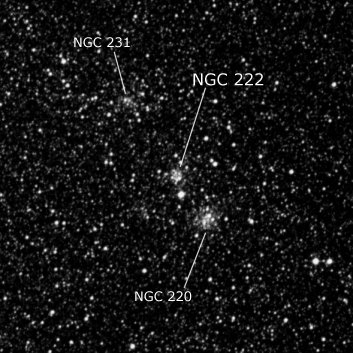
John Herschel discovered NGC 222 = h2339 on 11 Apr 1834 and simply recorded "vF, R, outlying." His position, though, is unusually poor - landing 3.7' S of NGC 220. Since h2339 was only recorded on the single sweep 441, Harold Corwin suggests this number may be another observation of NGC 220, which was recorded on 3 later sweeps, but not the one on 11 Apr 1834! As NGC 220 is much more prominent than the smaller cluster taken as NGC 222, it seems unreasonable that JH would have missed NGC 220. On sweep 625, JH recorded NGC 220 as "The first of an irregular string of nebulae and stars which descends at an angle of about 45 degrees from the centre to the edge of the field (i.e. in a north-following direction)". It's very possible that the cluster taken as NGC 222 was one of these "string of nebulae and stars" as it is just 1.5' NE of NGC 220, so perhaps he did see the cluster on this date. See Corwin's notes for more on this identification.
James Dunlop's D 2, discovered on 1 Aug 1826, may refer to this chain. He described a "faint nebula, about 1 1/2' long, irregular figure, rather branched. This is involved in the margin of the Nebula minor." His position is ~3.5' WNW of NGC 220/222 but given his general poor positions, this identification is not certain, and more likely would apply to NGC 220 (brightest cluster). Herschel assigned D 2 to NGC 231 = h2340.
Pietro Baracchi observed the cluster on 16 Dec 1887 (second of 14 objects) with the Melbourne telescope and called it "pB, roundish, pS lbM, amidst stars."
400/500mm - 18" (7/10/05 - Magellan Observatory, Australia): second and the smallest of three SMC clusters in a string with NGC 220 1.5' SW and NGC 231 2.5' NE. At 228x, it appeared as a fairly faint, small, round glow of ~30" diameter, unresolved. A mag 11.5 star lies 30" south.
Notes by Steve Gottlieb